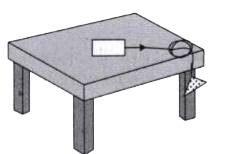Static friction is a self-adjusting force . Jutify the statement .
Video Solution
Text Solution

Consider a block of mass .m. connected to a thread which runs over a pulley and the other end of it is connected to a pan. If we keep on adding small weights, the block does not start sliding at the first attempt. The block starts moving only when the weights in the pan balance and are slightly greater than the frictional force (limiting friction) between the block and table. since static friction itself will change or self - adjust to provide an equal and opposite force till the force applied to the object is less than or equal to maximum static friction .
|
Topper's Solved these Questions
- AMAZING AIRBook:PEARSON IIT JEE FOUNDATIONChapter:AMAZING AIRExercise:Very short Answer Type Questions
Explore 20 Videos
- AMAZING AIRBook:PEARSON IIT JEE FOUNDATIONChapter:AMAZING AIRExercise:Short Answer Type Questions
Explore 29 Videos
- ENVIRONMENT- AN ETERNAL GIFT TO MANKINDBook:PEARSON IIT JEE FOUNDATIONChapter:ENVIRONMENT- AN ETERNAL GIFT TO MANKINDExercise:Crossword
Explore 1 Video
Similar Questions
Knowledge Check
Assertion : Static friction is a self-adjusting force upto its limit μsN where μs is the coefficient of static friction.
Reason: One can use the equation fs=μsN only when the maximum value of static friction comes into playAIf both assertion and reason are true and reason is the correct explanation of assertion.BIf both assertion and reason are true and reason is the not correct explanation of assertion.CIf assertion is true but reason is falseDIf both assertion and reason are false.This section contains Assertion (A) and Reason (R) type questions. Each question has 4 choices (a), (b), (c) and (d), out of which only one is correct.
38. Assertion (A) Static friction is a self adjusting force
Reason (R) Because friction changes itself in accordance with applied force and is always equal to net external forceABoth Assertion and Reason are correct and Reason Is the correct explanation of the AssertionBBoth Assertion and Reason are correct but Reason is not the correct explanation of AssertionCAssertion Is correct but Reason Is IncorrectDAssertion Is Incorrect but Reason Is correctAssertion: Static frictional force is a self adjusting force.
Reason: Force of static friction does not depend upon the mass of the body.AIf both assertion & Reason are True & the Reason is a corrrect explanation of the Asserion.BIf both Assertion & Reason are True but Reason is not correct explanation of the Assertion.CIf Assertion is Trie but the Reason is False.DIf both Assertion & Reason are false
A : Static friction force is a self adjusting force.
R : The interatomic forces at the point of contact give rise to friction between the surfaces.
View SolutionExplain that static friction is a self adjusting force .
View SolutionStatic friction works when:
View SolutionAssertion: Friction is a self-adjusting force.
Reason: Friction does not depend upon mass of the body
View SolutionAssertion: Friction is a self-adjusting force.
Reason: Friction does not depend upon mass of the body.
View Solution